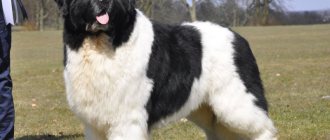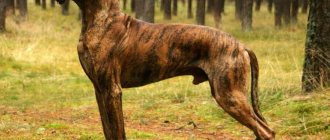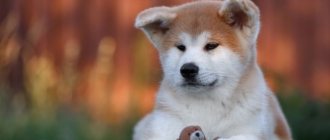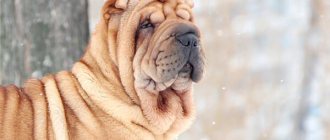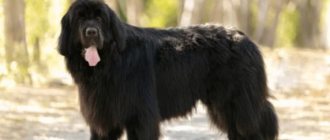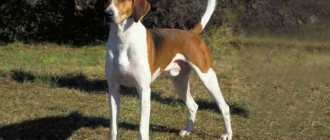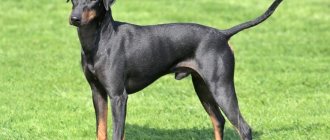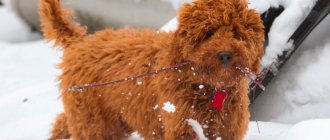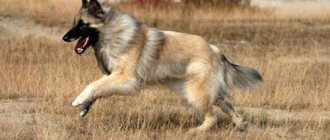Shar Pei is both a very ancient and very young breed. These dogs lived in China for centuries and millennia, helping peasants and sailors in their difficult work.
But as a breed, these dogs were recognized about forty years ago, and their first standard appeared in 1976. And if in the 70s and 80s of the 20th century they were so rare that they were even included in the Guinness Book of Records, but now these dogs have long enjoyed well-deserved popularity all over the world.
History of the breed
Many modern dog breeds have Chinese roots, especially small and medium breeds. Shar Pei dogs also originated in ancient China, when it was ruled by the famous Qin Dynasty. Unfortunately, there is no reliable information about exactly how the first Shar Pei appeared.
There is a theory that all stud books and all documentary records about the process of breeding this breed were deliberately destroyed by Emperor Shi Huang. Scientists were unable to find out what the emperor’s goal was.
Based on anatomical similarities and general character traits, it can be assumed that the ancestors of the Shar Pei were ancient mastiffs and smooth-haired chow-chows. Using laboratory research, it was determined that the period of existence of Shar Pei dogs is three thousand years.
Initially, these dogs lived only in a few provinces of southern China.
Already in the 2nd century BC. e. Shar Peis have become the most popular breed among the country's population. During archaeological excavations in ancient tombs, clay figurines were discovered in the shape of a frowning dog, which is completely covered with folds. This breed was popular not only among the nobility; they were also often found in the homes of ordinary Chinese.
During the reign of the Communist regime, there was no place for Shar Pei dogs, like many other pets. Mao Zedong's supporters, like himself, considered pets unnecessary. Therefore, the mass extermination of cats and dogs began. The severity of World War II contributed to the almost complete disappearance of pets. According to official information, by the beginning of 50, there were only a few Shar Pei dogs left throughout China.
Only in the 70s did the first Shar Peis appear in Europe
Shar Peis amazed Europeans so much that they made it into the newspapers. Caring breeders began an active struggle for the revival of these dogs. They found eight purebred Shar Peis in the Chinese provinces, which became the basis for the revival of the breed.
To speed up the process of reviving the breed, crossings were carried out with other breeds that had similar appearance or character traits. It was possible to develop the first purebred pedigree only in the 76th year of the 20th century. In the same year, the official breed standard was approved. After this, Shar Peis actively spread throughout Europe and America. They came to Russia only at the end of the 20th century.
Education and training
In order for a dog to be kind and sociable, a Shar Pei needs to be accustomed to people from puppyhood and often walked.
Inexperienced dog owners may find it very difficult to make friends with such an animal; the dog does not always follow commands due to its freedom-loving nature.
It is recommended to begin training and socialization of a dog at three months. It is almost impossible to raise an adult, therefore, the sooner you accustom a Shar Pei to society, the better.
Already from the first teams it is worth showing your steadfastness and determination. You can start with the lessons: “You can’t”, “Place”, “To me”.
Expert opinion
Anna Abramenko
An avid dog lover. Experience in veterinary medicine since 2009.
Ask a Question
It is recommended to hire a dog trainer to train your dog.
Breed standard
- Representatives of the ancient Chinese breed are characterized by a strong, dense build.
- At the same time, the dogs are mobile, active and sociable.
- The body shape resembles a square, the length of the back is almost equal to the height of the dog at the withers. This feature is more clearly expressed in males.
- The height at the withers of an adult male varies between 50 centimeters, the height of females varies from 45 to 51 centimeters.
- Shar Pei girls weigh from 18 to 25 kilograms, while males can weigh up to 35 kilograms.
- The dogs have a strong, broad back.
- The abdominal line is moderately tucked.
- The tail is placed high, at the tip it is thinner and curls.
- The length of the paws is average, they are smooth and not covered with folds.
- The head of these dogs is large and the skull is flat. The presence of folds in the forehead and cheeks forms a dewlap. This breed is characterized by the presence of a wide muzzle, which resembles a hippopotamus.
- The breed standard allows for a slight convexity near the nose. The animal's nose is quite large with wide nostrils. Its color can be black or pink.
Coat type
The standard specifies two types of wool; in fact, there are many more. Many of these types are transitional between Horse and Brush and differ from them in a slightly softer or coarser coat .
For example, a type of coat that does not have official recognition, but is widespread among Shar-Peis, which some breeders call velor, is the same horse in length, only softer to the touch . Among all types of wool, the so-called bear wool stands out - also soft, like velor, but at the same time exceeding the length of brush .
ATTENTION! The Shar Pei's coat should be hard and thick. It rises slightly above the surface of the dog’s skin on the body and neck, but on the head, ears and limbs it should be shorter and fit tightly to the skin. The coat of dogs of this breed is healthy in appearance and thick, but does not have shine or, let alone, gloss.
Horse
Very short and stiff hair, similar to horse hair, is called horsecoat. This coat has a stubble-like feel and is more likely than any other to cause contact dermatitis when touched.
Important! The length of the horse's coat should not exceed 1 cm.
Brush
Brushcoat, or bristly coat, the length of which should not exceed 2.5 cm at the withers. The guard hair is softer than that of the Horse, but very elastic and thick.
Bear
Very long and soft, plush coat, noticeably different from standard horse, brush and even all transitional types, including velor.
In appearance, a Shar Pei with such fur looks more like a Chow Chow than a representative of its breed, and bear puppies, especially those of light color, are adorable.
Nevertheless, the interesting and in its own way attractive bear type of fur is outside the standard and is considered a breeding defect .
Appearance and coat colors of the Shar Pei
- A distinctive feature of Shar-Pei dogs is their frowning gaze.
- The eyes are dark in color.
- The ears are small, triangular in shape with rounded tips.
- Due to their fighting qualities, dogs have strong, well-developed jaws.
- The color of the tongue, palate and gums is a shade of blue.
- The main feature of Shar Pei dogs is the presence of folds of skin.
- The body is covered with short bristly hair, the hairs are stiff, and there is no undercoat.
Key points in training
Aboriginal breeds, which include the Shar Pei, are considered one of the most difficult to train. It is not recommended for beginners in dog breeding to engage in training on their own. It is necessary to contact professional dog handlers and animal psychologists who work on the basis of conflict-free training. Or raise a pet under the strict guidance of a breeder.
This breed needs to be able to be interested in activities, then you can get a well-bred dog.
Read about how to properly train a dog in the article: “Training a puppy: effective methods from dog handlers, learning commands at home.”
The types of coats of Shar-Peis can be divided into the following categories:
- Horse hair (horse).
- Brush-shaped (brush).
- "Bear fur."
The breed standard allows for many color variations. The most common colors are black, cream, fawn, mahogany (reddish), blue, isabella, and sable. In addition to the main color, the animals have black pigment spots similar to a mask and a belt on the back.
A color with no black spots is allowed.
- Cream.
- Apricot.
- Chocolate.
- Lilac color.
There are also dogs of non-standard colors:
- Spotted.
- Black-and-brown (black-brown).
In the first option, the main color is white, on which specks are placed. With the saddle color, the back is black and the tan marks are light in color.
Non-standard color: what does it look like?
I’ll tell you a little about non-standard colors, which are currently considered defective:
- Albino – I think it’s clear what’s going on here. Albinos often have serious health problems. And in any species of animals. These are completely white dogs with light eyes and noses.
- A spotted dog is a whole scattering of spots on a white background. The spots can be different - chocolate, black, blue, red. The British call this option “flowered” . Now, if readers come across this term somewhere, they will know what we are talking about. This option is translated as “floral”. It really looks very nice and is even in some demand. Despite the fact that flower dogs are not officially included in the standard. However, fans of this color are making attempts to achieve official recognition of the spotted Shar-Pei.
- Black hair - characterized by mixing black hair with light hair. Or there is zoning. Most often, according to my observations, such dogs have a black back and light tan marks. Or it may be similar to the sable color.
I hope that after this article, Shar Pei owners will look at their pets with completely different eyes. Of course, if the dog is perceived purely as a companion, color is not so important. However, if you are planning professional breeding and exhibition life, you cannot do without knowing all the nuances.
Shar Pei character
It is worth noting that this breed has a complex temperament and pronounced leadership qualities. Therefore, caring for and raising a Shar Pei is not an easy task. It is not recommended to have such a dog for people who lack self-confidence, lack leadership qualities, or have a fear of dogs.
And also the dog may not find a common language with small children and other animals living in the house. From the first minute in a new home, the Shar Pei requires proper education and training.
Despite his small size, he will try to win the leadership position. If the owner proves himself to be a strong “leader,” the dog will become his most faithful and devoted friend. Shar Peis can be infinitely kind and affectionate.
The character of the Shar Pei is complex, but the breed also has many positive qualities . Such a pet is an excellent watchman and security guard. What is important is that he will greet a stranger with a loud, threatening bark, but will never make unnecessary noise for no reason.
The main feature of the Shar Pei is culture and restraint. These dogs are not intrusive, even during outdoor games. Owners of Shar Pei puppies confirm the high intelligence of their pets. They follow the rules clearly established by the owner, are well oriented in the area, and remember the road. Dogs are characterized by restraint, balance and devotion.
Choosing a puppy and the price of Shar Pei dogs
Even before purchasing a Shar Pei puppy, you should carefully read the standard in order to know which appearance traits are a defect and which are just a minor drawback. You should definitely look at photos of dogs on the Internet, or even better, visit a special breed exhibition to get an idea of the appearance, types, sizes and characters of this diverse breed.
It is better to decide in advance on the gender, as well as the desired color out of 14 possible. And of course, think about the purpose for which the dog is purchased: will it be just a pet or in the future should it attend exhibitions and be a producer. The next stage is marketing research, calling breeders, getting to know prices and pedigrees, choosing parents or a puppy from the litter.
When choosing a puppy, you need to carefully examine it. There are no dried crusts on the face, the fur and skin are dry and clean, the eyes are open quite wide, the eyelashes look forward, the tongue is blue or lavender depending on the color. Pay attention to the puppy's behavior. He should not be overly fearful or aggressive; a good baby is curious, friendly and playful. It is advisable to take puppies to a new home no earlier than 2 months.
Prices
The cost of a puppy in nurseries varies widely: from 25,000 rubles. and higher. The price is influenced by the geography of the nursery, the merits of the parents, the appetites of the breeders and many other factors. The only option to buy a purebred dog cheaper (not taking into account exceptional cases) is to find a pet-class puppy with minor flaws in appearance, which automatically excludes it from breeding and significantly reduces the cost. This could be an uneven color, a spotted or pink tongue, an incorrect bite, erect ears, etc. The breed is very common and many people sell dogs secondhand. The price of puppies without documents rarely exceeds 15,000 rubles.
Care and maintenance
Due to their compact size and cleanliness, Shar Peis are suitable for keeping in private homes and apartments. Animals easily endure long trips in the car.
Two walks a day will be enough for them. In the summer, it is not recommended to take your pet outside from 11 to 17 pm, as the heat will cause them discomfort.
If you choose these animals, caring for them will not cause you any trouble. Shar Peis do not like water, but they need to be bathed once every 2 months. Trim your nails every month. Clean your ears once a week with cotton swabs.
Teaching your puppy the rules of behavior must begin from the first days. It is worth clearly identifying the things you can play with, and be consistent and categorical in your prohibitions. Dogs are smart enough, so there are no problems with training. But during classes there is no need to put pressure on the animal. It is worth showing the task and giving the dog time to comprehend it. Under no circumstances should you hit a dog. The use of force will instill anger and uncontrollability in the Shar Pei.
Keeping a Shar Pei at home
These pets are not difficult to keep. Despite this, there are some nuances that must be taken into account based on the breed characteristics of the dog. These are unique dogs, but they can pose a number of challenges when caring for them.
Care and hygiene
Since the dog's hair is short, caring for it is not difficult; it is enough to comb it once a week with a special brush. When the molting period begins, you will have to use a special mitten or furminator. This approach will allow you to get rid of hair in the house, and also deprive your pet of discomfort. The fact is that Shar-Pei's fur is quite hard and prickly, so it requires regular removal. Water procedures are optional, although a couple of times a year can be organized, although few of the individuals will be noticeably happy with water procedures.
Important to remember! Since the skin on certain parts of the body forms characteristic folds and dewlap, they also require special care. The folds on the face should always be wiped with a soft cloth after the dog drinks water. In addition, after eating, food remains in the folds, which also need to be removed. At the same time, you should not lubricate these places with ointments or sprinkle them with powders without consulting a veterinarian.
Naturally, you will have to take care of the cleanliness of your ears, for which you use cotton swabs. They are moistened in a special liquid, which is sold in veterinary pharmacies. Use cotton pads to clean the Shar Pei's eyes if dirt accumulates in their corners, as well as discharge from the eyes. If the dog has enough toys and the pet is given special treats, then additional teeth cleaning activities will not be necessary.
When a dog is walked, the claws wear down naturally if the dog walks on a hard surface. If this is not possible, then you can use a nail clipper. These dogs easily tolerate subzero temperatures, so they practically do not need additional clothing up to minus 20 degrees. If the temperature is lower, then a special overall will come in handy. It is advisable to keep these dogs in a house or apartment, since they are not very adapted to long stays in the cold. A demi-season overalls, which will protect your pet from dirt and other external influences, will also not hurt.
What to feed
The difficulty is that it is very difficult to choose the right diet for this dog. This is due to the fact that many Shar Peis suffer from intolerance to certain foods. Experts recommend choosing super-premium or holistic ready-made food for these pets. At the same time, feed is gradually added to the main feed, observing the behavior of the animal.
The option of feeding natural food is possible, given the fact that a pet eats up to 1 kilogram of various foods per day. Half of the diet should be lean meat, offal, and fish. The second half of the diet is formed by porridges prepared with buckwheat, oatmeal and rice. In addition, your pet’s menu should include fermented milk products, as well as vegetables and herbs.
Important! After purchasing a puppy, the basis of the diet should be those products that were used by the breeder to feed it. The transition to a dog's diet that is more convenient for the owner should be carried out gradually.
As a rule, small puppies are fed up to 6 times a day. The frequency of feedings is gradually reduced to 2 times when the animal reaches 1 year of age. The diet is formed based on the dog’s individual preferences, while those foods that the animal refuses or eats reluctantly are excluded from the diet.
Diseases and breed defects
This breed, like many others bred artificially, is predisposed to a number of hereditary ailments, such as:
- Shar Pei fever.
- Seborrhea.
- Demodecosis.
- Dermatitis.
- Hypothyroidism.
- Food allergies.
- All kinds of tumors.
- Dysplasia.
- Tight lip syndrome.
- Turning of the eyelids.
- Otitis.
It is important to know! If you successfully select a puppy and then provide it with comfortable living conditions, then a number of health problems for your pet can be avoided.
Breed defects
These problems include:
- Pink tongue and palate.
- Erect ears.
- Tail too short.
- Any body color, as long as it is not solid.
Training and education
Once born, Shar-Peis are characterized by autonomy and independence, so they need to be properly raised and socialized from an early age. These animals do not allow themselves to be treated with disrespect, always acting evilly towards their owner. Therefore, the process of education and training should not be accompanied by shouting and violence. Persuasion and affection are the main components that will help you get a positive result in raising such a pet. Only in this case will the dog make contact, understanding what his owner wants from him.
It is important to know! You should not allow the slightest signs of aggression, either towards the owner or towards members of the household, immediately stopping such behavior of the animal.
These dogs are capable of showing unmotivated aggression towards other dogs or animals. In this regard, walks with a Shar Pei should be carried out exclusively on a leash. To prevent an animal from showing aggression towards its own kind, this should be taken care of from an early age, accustoming the pet to the company of other dogs and other animals.
Correctly and competently organized processes of education and training always bring positive results. In this case, a loyal and devoted friend grows up for all family members, who does not show aggression towards strangers or other animals.
How to raise Shar-Peis
Composition and nutritional standards
An adult dog will only need one or two meals a day. Puppies up to three months need three feedings, and up to six months – two. It is worth remembering that Shar Pei under the age of six months can only be fed wet food or dry food soaked in broth. Dry food is more convenient because it contains all the necessary vitamins and minerals, but choose high-quality brands.
If you decide to stick to a natural diet, then your diet will be something like this:
- Rice porrige.
- Lean meat in raw form.
- Sea fish fillet (pre-scald with boiling water).
If desired, you can diversify the menu with vegetables, fruits, eggs and dairy products are occasionally allowed. But do not forget that Shar Peis have an innate tendency to allergies, so give new foods in small portions.
Health: diseases and life expectancy
Many people consider Shar Peis to be very sickly dogs and there is some truth in this. Modern breeders are increasingly approaching breeding issues more responsibly and selecting only healthy sires and, if possible, doing genetic carrier tests, but this was not always the case. In addition, the breed has complex genetics, which entails a number of pathologies and makes dogs prone to many diseases.
A few Shar Peis can boast of excellent health. Most owners will have to deal with various ailments in their pet more than once.
- Like other brachycephalic breeds, the Chinese Shar Pei can suffer from characteristic respiratory problems (stenosis of the nostrils, elongation of the soft palate, enlarged laryngeal folds, hypoplastic trachea). Puppies under 12 weeks of age are prone to developing bronchial pneumonia.
- Dermatological problems: allergic dermatitis, sarcoptic mange, bacterial skin infections, seborrhea, Malassezia dermatitis, malignant and benign skin tumors. Mucinoma is an autoimmune disease in which the substance mucin accumulates in the skin. Shar Peis are prone to forming abscesses as a result of various penetrating wounds.
- Ophthalmological diseases are also characteristic of the breed. The most common problem is entropion of the eyelids. Diagnosed upon examination, without surgical intervention it can lead to corneal trauma and blindness. Retinal dysplasia, glaucoma, and prolapse of the third eyelid also occur.
- The peculiarity of the structure of the ears, the complexity of their ventilation and cleaning often become predisposing factors in the development of otitis media of various etiologies.
- Panosteitis and hypertrophic osteodystrophy are two diseases of the musculoskeletal system that are often recorded during the period of active growth of puppies. Shar-Peis are also diagnosed with weakness of the wrist joint, dislocation of the patella, dysplasia of the hip and elbow joints, and osteochondrosis dissecans.
- Hypothyroidism is quite widespread in the breed.
- Bite abnormalities;
- Thick lip syndrome (excess tissue on the lower lip covers the teeth). Sometimes the problem does not prevent the dog from living, but in case of permanent trauma, surgical intervention is required.
- Chronically intestinal inflammation;
- Allergies to plants, insect bites, food components, care products and more.
- Hereditary fever or swollen joint syndrome is a disease of the immune system unique to this breed.
Shar Pei owners should closely monitor the health of their dogs in order to notice the first symptoms of a developing disease in time. In addition, Shar Peis need standard veterinary preventive measures: examination, vaccination, treatment for external and internal parasites. Average life expectancy is 8-12 years.
What do Shar Peis get sick with?
Despite good health, representatives of the Shar Pei breed are prone to certain diseases, namely:
- Pathology of the eyes and ears.
- Skin diseases (dermatitis).
- Thyroid gland dysfunction.
- Tumors of internal organs.
To protect your dog from serious illnesses, when the first symptoms appear (an unpleasant putrid odor from the skin, poor appetite or refusal to eat, decreased physical activity), contact your veterinarian.
This breed has a fairly strong innate immune system and good health, but the pet needs to be vaccinated regularly. By providing proper living conditions in an apartment or private house, you guarantee a long life for your four-legged friend. The average lifespan of the Shar Pei breed is 12 years.
Advantages and disadvantages
Benefits of Shar Pei:
- Small dimensions.
- Service qualities.
- Devotion to the owner.
- High intelligence.
- Easy care, cleanliness.
- Calm character.
Disadvantages of Shar Pei:
- Problems with training and gaining authority.
- Scrupulousness in choosing food.
- Aggression towards foreign animals.
- Short life expectancy.
Choosing a puppy
To purchase a Shar Pei puppy, it is recommended to contact specialized nurseries or trusted breeders. It is better to buy puppies from the age of two months.
When choosing a puppy, pay attention to the following external characteristics:
- The chest should be well developed.
- The body is square (not elongated).
- Parallel placement of the front paws.
- No narrowing of the muzzle.
Check the cleanliness of the skin and the absence of discharge from the eyes and ears. A small Shar Pei should be playful and active.
To purchase a Shar Pei without documents, you will need to pay at least 8 thousand rubles. And for a baby with a good pedigree, breeders ask from 40 thousand rubles. In the US, prices for this breed range from $150 to $500.
Mating
Mating is allowed for males aged 18 months and older. Bitches are at 4 sexual estrus, but not earlier than they are one and a half years old. The dog must have time to fully develop to avoid problems with the bones.
Sick individuals or those with disqualifying exterior defects are strictly not allowed for breeding.
A male dog can inseminate at least every month. Bitches are prohibited from being bred more than once a year; this will lead to exhaustion of the body and a high probability of giving birth to sick offspring.
Estrus occurs on average, as in all breeds, on the 10th – 14th day of estrus. Depending on the individual characteristics of the organism, these data may vary from -2 to +4 days .
Read a detailed article on the topic: “Everything you need to know about breeding dogs: appropriate age, what to do if it doesn’t work out, rules and tips.”
Historical facts
- In the 70s of the 20th century, Shar Peis were listed on the pages of the Red Book. During this period they were the rarest breed in the world. To buy such a puppy, you had to pay a couple of thousand dollars.
- Shar Peis were often used as watchdogs and guards. But in ancient Tibet they took part in dog fights. In these latitudes the breed was called the “Chinese fighting dog.” The peculiarities of the skin, namely the presence of many folds, provided the dogs with relative safety. Because during the fight the enemy damaged the skin, but could not damage the internal organs.
Features of character and behavior
Shar Peis are called philosopher dogs, this speaks volumes about their behavior. Calm, balanced, thinking, independent, independent and unobtrusive friends of a person. They do not like fuss, are not inclined to conservatism, are leisurely, even a little imposing - these are the real breed traits of the Molossian aborigines.
Many people believe that Shar Peis are stupid dogs due to their training habits. But the Chinese, who call them thinkers, say that the labyrinths of the mind appear on their foreheads.
Many are sure that the Shar Pei is a fighting breed; in Russia and Belarus it is included in the list of potentially dangerous dogs, but this is complete nonsense.
Due to the movable skin, they were actually tried to be used in battles in the 17th century, but this idea was soon abandoned due to the lack of aggression. Moreover, not a single canine organization in the world recognizes such a thing as a “fighting breed”.
The Shar Pei is an absolutely versatile dog. Previously, they were used for hunting, protecting houses and livestock. We fought against mongooses that attacked peasant birds. For a short time they were even used as shepherds. Today it is a companion dog. People who have encountered a Shar Pei at least once call them thinking or understanding companions.
Treats strangers arrogantly, with distrust, but without aggression . With a good level of socialization, he does not show aggression at all. But in the manifestation of his feelings he will be restrained, like a true eastern sage. If the dog is in complete social deprivation, or rarely leaves the territory of its territory, it may exhibit protective qualities.
They love their family members endlessly, although sometimes they can be stubborn. Children are treated tolerantly, especially female Shar Peis. The maternal instinct in female dogs is so developed that they can become excellent nannies for a child.
They may seem a little phlegmatic or even melancholic, do not fetch fetch, and are indifferent to toys after changing teeth. But during hunting or playing with their brothers, they turn into playful, perky puppies. It becomes unclear where these lazy people get so much energy.
There may be some difficulties in communicating with brothers.
Shar-Peis, especially during the growth period, have a rather loose structure of the nasopharynx; with rapid breathing, wheezing can be heard, which some dogs may perceive as a growl and respond with aggression.
In addition, Shar Pei has a rather specific smell that is not characteristic of domesticated dogs. Representatives of this breed are recommended to make friends who are the same age since childhood, then there will be no problems.
Advantages
The Shar Pei has many advantages. A very smart, calm, balanced dog. A true Eastern philosopher, with all that implies. He doesn’t make unnecessary movements, doesn’t show aggression, knows how to restrain his emotions, and doesn’t impose his company. He even has some intelligence, aristocracy and neatness.
The French have a saying: “If you walk down the street with a Shar Pei, don’t be surprised if no one notices you.”
The main advantage of the Shar Pei is its appearance. A dog of extraordinary beauty, incredibly cute and unusual exterior. Literally translated, “Shar Pei” means a sand dog; when you pet them, you get the feeling that sand is rolling in your hands.
Flaws
Not suitable for sports training, obeys commands lazily and reluctantly. Before carrying out an order, he must be given time to think. He has a stubborn temperament and an independent character. Speaking in “human” characteristics, he is touchy. Absolutely not suitable for any types of services (police, Ministry of Emergency Situations, etc.).
